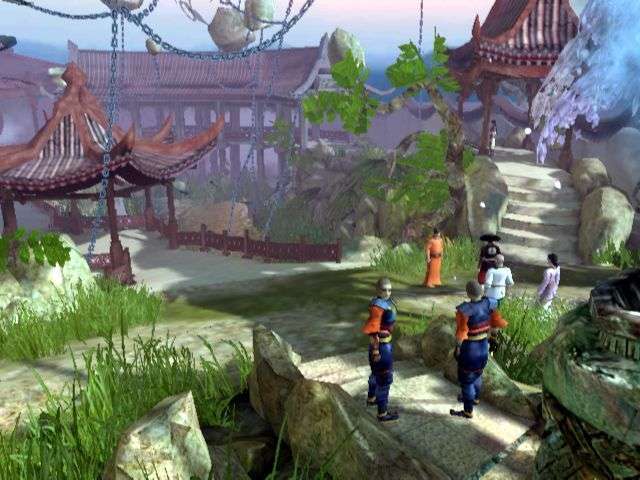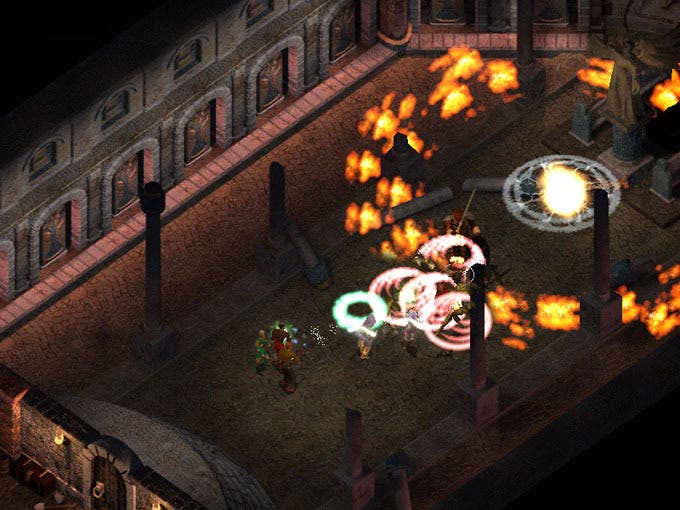The History of BioWare
They just keep rolling.
The game met with almost universal adulation, although there were a few dissenting voices, like this snot-nosed review site here which boldly ice-skated uphill, slapping it down with a 7/10 and an admittedly reasonable grumble about the rather stodgy single-player campaign. Thankfully, the modding community had always rallied around Baldur's Gate, so Neverwinter Nights wisely shipped with the game's toolset available and ready for use by fans. Improved quests were soon blooming all over the internet, like so much role-playing lichen. BioWare also supported the game with their own official expansion packs, and later through smaller downloadable modules, while the game brushed seductively alongside the world of the MMORPG with a hefty multiplayer component that enabled players to join up across the internet to tackle the main story. Naturally, there have been mods since which essentially turn the game into a massively-multiplayer experience.
For their follow-up project, the BioWare team faced two difficult tasks: transferring their rich, velvety RPG goodness into a form that would appeal to console gamers, while also navigating the treacherous waters of a beloved, yet often mishandled, movie licence. Star Wars was the name, and Knights of the Old Republic was the game. With the prequels disappointing many, they needed something special to reinvigorate a jaded fanbase, and setting their adventure four thousand years before the baby-faced Anakin Skywalker first yippeed his way into infamy gave them just the distance needed. Science-fiction writer Drew Karpyshyn had joined the BioWare staff just prior to the release of Baldur's Gate II, and wrote the official novelisation of that game, and it was his expertise that helped to shape Knights of the Old Republic into one of the more interesting narrative gaming experiences of the last generation.

Released exclusively for the Xbox, with a PC version following several months later, the game offered far fewer opportunities to roam than previous BioWare offerings but compensated with a streamlined approach to the RPG genre that retained the reliable statistical bedrock of old (even here, they couldn't escape - the basis of the game's rulebook is once again the Advanced Dungeons & Dragons 3rd Edition) but tucked it discreetly out of the way where it wouldn't scare those uninitiated in the ways of the mouse. The game even managed to take turn-based combat and make it exciting, offering an intuitive battle system that drew inspiration from the Final Fantasy series to offer room for tactical thinking, while maintaining a frenetic pace. Players were also offered the choice to follow the Dark Side of the Force, although in reality the choice only really impacted the game at the very end.
Front and centre were lush visuals and a cleverly designed story that borrowed familiar tropes from the Star Wars movies and used them to deliver one of the more effective plot twists in gaming history. It may have relied on the old amnesia ploy for its impact, but few who slowly uncovered the secret of Darth Revan would begrudge the writers this indulgence, so ridiculously entertaining was the end result. In the end, the limp reception that greeted The Phantom Menace and Attack of the Clones may even have helped Knights of the Old Republic, their leaden pace making its old fashioned mix of high melodrama and swashbuckling adventure seem all the more faithful to the original Star Wars spirit. Indeed, the game prompted renowned grouch Keiron Gillen to declare it "the first successful Western-style console Role-Playing Game of the modern age" and even admit that it "takes something that's been merchandised, franchised and branded to death over the last twenty-five years and makes it magical again". And this is a man who emphatically hates Star Wars.

Having spent much of its existence playing in other people's toy boxes, BioWare took advantage of their newfound console fame and developed their first original property since...well, since Shattered Steel. Jade Empire, however, wasn't quite as original as some hoped. Set in ancient China, it followed the successful Knights of the Old Republic template extremely closely, with two philosophical paths to follow - Open Palm (hooray!) or Closed Fist (boo!) - and a big old twist at the end. While introducing real-time martial arts combat to the RPG combat system was certainly a bold idea, many grumbled that the game was rather short and less than challenging for those who were now familiar with BioWare's modus operandi. Reviews were warm, but a far cry from scorching hot passion that Knights of the Old Republic had attracted. "It falls sadly short of the status of all-time classic which some seem to want to confer upon it," sighed Rob Fahey as he rustled up a rather forlorn 8/10 for it.
And yet BioWare's lustre remained undimmed by this less than ecstatic reception. Most RPG fans still recognised a company that was driven by narrative complexity married to technical innovation, and eagerly waited to see what would be next from the Canadian wonders. Something special, was the answer.

Conceived as a vast trilogy, with Drew Karpyshyn once again working on the story and spin-off novels, Mass Effect promised to take all that was good about BioWare RPGs from Baldur's Gate to Jade Empire, refine it even further, slather it in spicy spacey sauce and serve it up in the sort of dazzling cinematic style only possible since the dawning of the mythical Next Generation. Did they succeed? Well, you'll have to wait and see (clue: yes) but there's still more to look forward to. As well as two further adventures in the Mass Effect universe at some point in the future, there's also Dragon Age (a "spiritual successor" to Baldur's Gate), a Sonic the Hedgehog RPG, BioWare's first proper MMORPG as well as a mysterious new LucasArts project. Ooh. Maybe we'll finally get that Ewoks: Caravan of Courage role-player...
